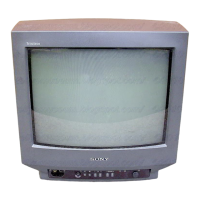
Do you have a question about the Sony TRINITRON KV-14FV300 and is the answer not in the manual?
| Screen Size | 14 inches |
|---|---|
| Display Technology | CRT |
| Aspect Ratio | 4:3 |
| Audio Output | Mono |
| Comb Filter | Yes |
| Weight | 15.4 kg |
| Inputs | Composite, S-Video, RF |
| Inputs/Outputs | Composite, S-Video, RF |
Provides instructions and diagrams for removing the rear cover of the TV set.
Details the process of removing the main chassis assembly from the TV.
Describes the specific steps and warnings for safely removing the picture tube anode cap.
Describes the specific steps and warnings for safely removing the picture tube anode cap.
Advises using an isolation transformer due to the live chassis connected to the AC power line.
Highlights critical safety components identified by shading and ! mark for safe operation.
Details procedures for checking AC leakage from exposed metal parts to ground, with specified limits.
Explains methods for identifying a reliable earth ground connection for safety checks.
Explains how the STANDBY/TIMER LED flash count indicates potential problems and lists diagnostic items.
Details the procedure for adjusting beam landing, involving degaussing and pattern generator setup.
Explains how to adjust vertical static convergence using the V. STAT magnet.
Describes adjustments for horizontal static convergence using BMC magnets.
Details adjustments for horizontal convergence of red and blue dots using the TLH plate.
Explains how to adjust screen-corner convergence using permalloy assemblies.
Outlines the steps to enter the service adjustment mode using the remote commander.
Describes the method for confirming and readjusting the R565 component for HV hold-down safety.
Procedure to confirm the hold-down operation by measuring current and voltage under specific conditions.
Details how to confirm and adjust the B+ voltage on the A Board, especially after component replacement.
Explains the procedure to enter and set the service adjustment mode using the remote commander.
Details various adjustments performed on the A Board of the TV chassis.
Details adjustments for vertical angle, bow, and pin settings of the deflection yoke.
Explains adjustments for linearity, correction, pin amp, and horizontal trapezoid.
Provides an exploded view of the chassis assembly for specific models, with part identification.
Warns about using the polarized plug with extension cords to prevent blade exposure.
Lists safety precautions for operating the TV, including voltage and plug usage.
Advice on protecting the TV from lightning and power surges by unplugging.
Lists conditions that require unplugging the TV and referring to qualified service personnel.
Warns against self-servicing due to hazardous voltages and refers all servicing to qualified personnel.
Recommends performing routine safety checks after service to ensure safe operation.
Provides guidance on connecting the TV to different types of antenna or cable sources.
Details how to connect a VCR to the TV using coaxial and optional audio/video cables.
Sets rating limits for TV programs based on age and content ratings.
Explains how to display and navigate the on-screen menu system using the remote control.
Adjusts picture settings like contrast, brightness, color, hue, and sharpness.
Selects sound modes like Stereo, Mono, or Auto SAP for broadcast audio.
Instructions for changing the Parental Control password.
Programs TV viewing by day, time, duration, and channel.
Provides steps to resolve issues with no picture or sound, including checking connections and settings.
Suggests adjusting picture and brightness settings to fix poor picture quality.
Offers solutions for no sound with good picture, like checking mute and audio settings.
Suggests adjusting color settings to resolve issues with lack of color.
Provides troubleshooting steps for when only snow appears, checking cable settings and antenna.
Provides steps to resolve issues with cable stations not working, including checking cable settings.
Suggests checking batteries and moving the TV away from fluorescent lights if the remote is unresponsive.
Explains how to enter a master password to reset a lost parental control password.












